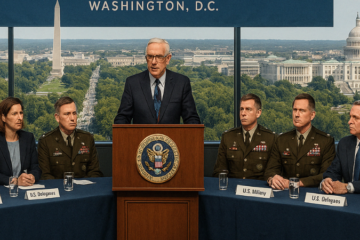The American approach to deterrence has undergone a significant transformation during the initial months of President Donald Trump’s second administration. Where President Joe Biden’s national security strategy was premised on the concept of integrated deterrence, Trump’s approach lacks coordination across the United States government and with key partners and allies. This is resulting in a state of disintegrated deterrence. Consequently, Australia and other allies of the United States will be compelled to adopt a distinct approach to their own deterrence and engagement with the United States.
The primary objective of Biden’s integrated deterrence strategy was to harmonize and unify the efforts of various government agencies and allied nations to deter aggression from China and other hostile actors. To achieve this objective, the strategy aimed to maximise the utilisation of all available tools of American power, encompassing diplomacy, intelligence, economic assistance, and force posture decisions. Integration with allies and partners was an integral component of Biden’s deterrence strategy and would be achieved by enhancing the interoperability of allied military forces and coordinating the diplomatic and economic initiatives of friendly nations.
While the goals of integrated deterrence appear sensible, many expressed concerns about the concept. Some claimed the term was not new or unique. It simply described the implementation of any effective, tailored deterrence strategy that leverage various organisations to prevent hostile actions.
American deterrence was executed in an integrated fashion throughout the Cold War by necessity, thanks to the size and significance of the Soviet threat. Concerns were also expressed that proponents of integrated deterrence overstated the ability of sanctions, diplomacy, and other non-military tools to prevent conflict. History shows that the threat of major military action has a unique strength in deterring an enemy, especially when that threat comes from a nation with a nuclear arsenal.
Regardless of one’s stance on integrated deterrence and its implementation, a coordinated US strategy that leverages the strengths of its allies should be preferred to the alternative currently being pursued in Washington. A lack of integration in deterrence matters is evident both within the US government and in its interactions with partners and allies.
Within the United States government, there are several reported disconnects between President Trump and senior members of his administration. For example, Secretary of State Marco Rubio was first informed of Trump’s proposal to take Gaza by military force and evict Palestinians while watching a press conference held by Trump and Israeli Prime Minister Benjamin Netanyahu. Furthermore, it was recently reported that Rubio is “privately frustrated that Trump has effectively sidelined him.” More recently, Signal messages disclosed highlight significant differences between Vice President Vance and President Trump on the timing and signaling associated with strikes on Houthi targets.
This lack of vertical integration diminishes the authority that the secretary holds in meetings with both allies and adversaries. Additionally, it eliminates the potential for any exchange of ideas that could transpire within the Department of State to develop more effective policy options to present to the president.
Horizontal integration of deterrence across various departments was also weakened, partially by budgetary cuts and eliminations of entire organizations. Foreign assistance and development resources were pivotal components of the 2022 Indo-Pacific Strategy. However, extensive cuts made to the United States Agency for International Development and other government agencies by the Department of Government Efficiency did not fully consider or comprehend the regional implications or potential negative impacts on deterrence.
To date, much of Trump’s foreign policy is focused on addressing conflicts in Europe and the Middle East. A strategy for dealing with China, beyond the use of tariffs and other economic measures, is yet to be revealed. There are lessons to be learned from what has transpired with allies facing a menacing Russian threat in Europe.
President Trump consistently urges the North Atlantic Treaty Organization’s (NATO) member-states to significantly enhance their defence expenditures, even suggesting that 5 percent of their gross domestic product (GDP) may be an appropriate threshold. For those nations that fail to meet NATO’s spending guidelines, Trump stated that US military support under Article 5 may not be available. While NATO nations were increasing defense spending prior to Trump taking office (a 20 percent increase in 2024), Germany and the United Kingdom (UK) recently announced plans to further bolster defense budgets.
While additional insights into Trump’s approach to allies in the Indo-Pacific are anticipated in the coming weeks and months, Australia should draw upon several valuable early lessons. The first pertains to the long-standing Canberra tradition of analyzing and dissecting the statements and writings of senior officials within an American administration to comprehend policy. Maintaining cordial relations with officials at all levels of the US government remains prudent, but it is uncertain whether statements from senior administration officials can be relied upon to fully reflect Trump’s perspectives.
Furthermore, the current level of Australian defense spending, which accounts for 2 percent of GDP, will not meet Trump’s expectations for allies. A pre-emptive move to increase defense spending to 2.5 percent of GDP by 2027, similar to what was announced in February by the UK, would demonstrate Australia’s national commitment to addressing its deteriorating strategic circumstances and to contributing more towards its share of the alliance. If President Trump has made one thing clear to allies, it is that if they do not value their own defense neither will he.
Carl Rhodes is founder of Robust Policy and a senior fellow with the National Institute for Deterrence Studies. Carl hosts the Deterrence Down Under podcast and previously spent 25 years with RAND Corporation. Carl has a PhD in chemical engineering from Caltech.




